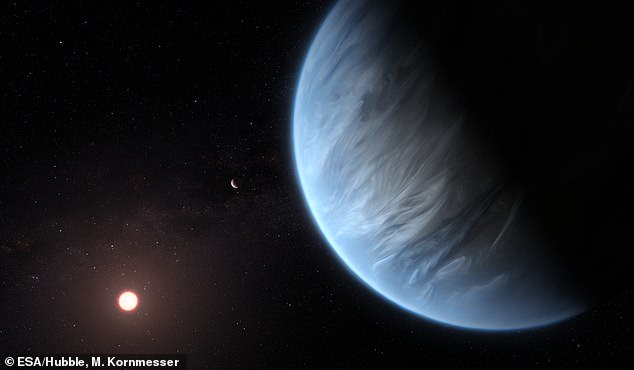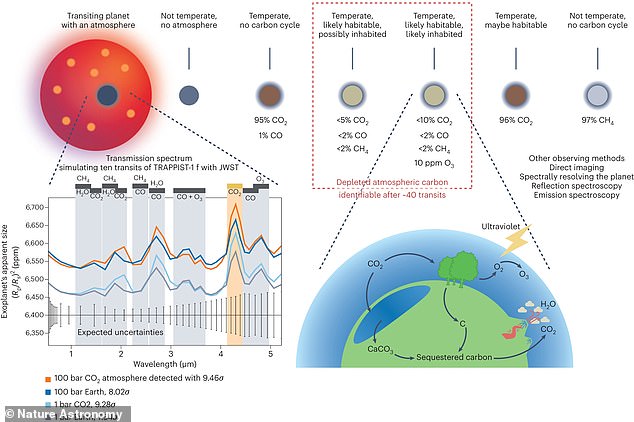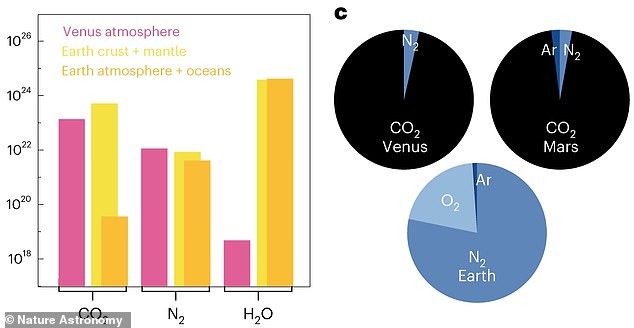Closer to finding alien life? Scientists identify ‘clue’ that could lead to uncovering inhabited planets in deep space
Scientists have identified new evidence in the search for alien life on distant planets.
A team from the University of Birmingham and MIT believes that distant worlds with low carbon dioxide levels may mean they are inhabited.
This proposal is due to the idea that a depleted level means that the oceans and plants are absorbing the chemical compound.
Scientists believe that NASA's James Webb Space Telescope is a prime candidate to search for lower levels, as the telescope has previously detected atmospheric conditions on exoplanets.

A team from the University of Birmingham and MIT has released new research showing that a planet with low levels of carbon dioxide in the atmosphere may have liquid water (reserves).
Julian de Wit, assistant professor of planetary sciences at the Massachusetts Institute of Technology, said in a… statement: 'The holy grail of exoplanetary science is the search for habitable worlds and life, but all the features talked about so far have been beyond the reach of state-of-the-art observatories.
“Now we have a way to find out if there is liquid water on another planet.
“This is something we can get to in the next few years.”
To date, astronomers have discovered more than 5,200 worlds outside our solar system.
Although techniques for searching for habitable planets have advanced, scientists have yet to discover the “Holy Grail.”
Current methods look for “shimmer” on planets that could mean light reflecting off water, which helped experts identify lakes on Saturn's moon, Titan.


A team from the University of Birmingham and MIT believes that distant worlds with low carbon dioxide levels may mean they are inhabited.
However, this is not possible with distant planets that have not yet been explored by human vehicles.
“We came up with an idea by looking at what happens with terrestrial planets in our own system,” said study co-author Martin Torbett.
The team said that there are similarities between Venus, Earth and Mars, as they are rocky and have temperate regions.
But Earth is the only planet that hosts liquid water and has much less carbon dioxide in its atmosphere.
“We assume that these planets were created in a similar way, and if we see a planet with less carbon now, it must have gone somewhere,” Treaud said.
“The only process that can remove this much carbon from the atmosphere is a powerful water cycle involving oceans of liquid water.”
The team designed a strategy to implement the new method, which involved first finding groups of terrestrial planets that orbit relatively close together, just like our solar system.
The next step will be to confirm which worlds have an atmosphere by looking for carbon dioxide.
“CO2 is a very strong absorber of infrared radiation and can be easily detected in exoplanetary atmospheres,” De Wit explained.


The team understood that there are similarities between Venus, Earth and Mars, as they are rocky and have temperate regions. But Earth is the only planet that hosts liquid water and has much less carbon dioxide in its atmosphere
“The carbon dioxide signal could reveal the presence of exoplanetary atmospheres.”
Next, the team proposed measuring carbon levels in the atmosphere.
However, researchers note that just because a planet has liquid water does not mean it is inhabited by life.
This idea led them to identify another feature: Does the planet have ozone?
“On Earth, researchers have observed that plants and some microbes contribute to carbon dioxide drawdowns, although not as much as the oceans do,” the press release said.
However, as part of this process, life forms emit oxygen, which reacts with the sun's photons to turn into ozone. This molecule is much easier to detect than oxygen itself.
If the exoplanet has a zone and depleted carbon dioxide, it is likely to be a habitable and inhabitable world.
“If we see ozone, chances are very high that it is linked to carbon dioxide that life consumes,” Treaud said.
If it is life, it is a glorious life. It won't just be a few bacteria. It would be a planet-scale biomass capable of processing and reacting to a huge amount of carbon.
(Tags for translation)dailymail
